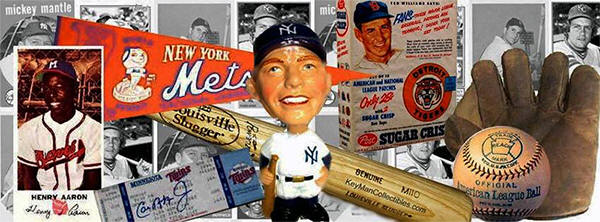The majority
of baseball sheet music published
in the 19th century featured
wordless polkas, march and two step
songs. It seems that they did more
marching than singing at the old
ball game. Many teams also had
their own songs back in the day
including the "Red Stockings March"
published in 1869, and "the New
York Giants March" in 1907.
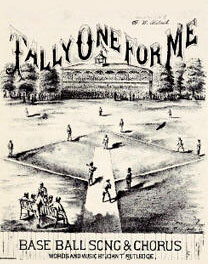
A song about scoring runs, the 1877
Polka "Tally One For Me" was one of
the earlier songs with lyrics.
Written and composed by John T
Rutledge, the player in the song
was ♪♪-the pride and pet of all the
girls that come out to the park-♪♪
As the chorus goes; "For when I take the bat in hand My style is sure and
free.... Just put your money on my
side and Tally One For Me" The
Sheet music for this " Base Ball
Song" was published by F.W.
Helmick of Cinncinati, and the
cover illustrates a 19th century
ball game in progress.
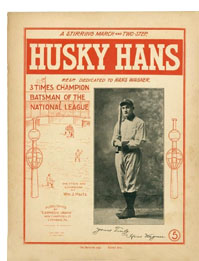 A stirring march and two step,
"Husky Hans,"
A stirring march and two step,
"Husky Hans," was written by
William Hartz of Carnegie, then
organized a band of marching
children to sing the praise of the
"3 Times Champion Batsman of The
National League" Honus Wagner.
The music was published as an
homage to Wagner by his hometown
newspaper, the Carnegie Union. The
sheet music went on sale for .25¢
at music stores on October 29,
1904. The cover title page featured
a "full length portrait of the
greatest of all baseball players,
and autograph."
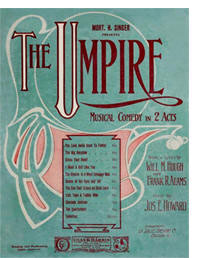
The
1905 theatrical musical comedy
hit "The Umpire" scored the song "
The
Umpire is the Most Unhappy Man,"
The play is about an Umpire named
Johnny Nolan, who makes such an
outrageous call he is forced to
flee to Morocco.
There at a football game he redeems
himself, and wins the hand of the
teams center, when it turns out the star player is a lovely young
lady named Maribel Lewton. The
sheet music for the "The Umpire is
the Most Unhappy Man," was
published by Chas-K-Harris of
Chicago, and was recorded on an
Edison Gold Moulded record cylinder
in 1906, by Edwin M. Favor.
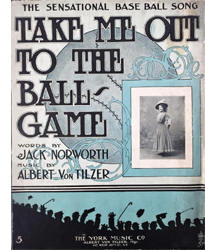
A song written in 1908 by Jack
Norworth and Albert Von Tilzer,
"
Take Me out to the Ball Game"
became the official anthem of
baseball. It is the third-most
frequently heard song in America,
behind the national anthem and
Happy Birthday.
Norworth who had never been to a
ball game, wrote the lyrics when he
passed the Polo Grounds on an
elevated train and saw a sign that
read “Baseball Today.” He later
wrote different verses for the song
in 1927, with "Nelly Kelly"
replacing "Katie Casey."
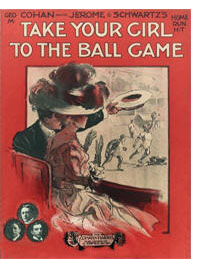
Day's after Albert Von Tilzer and
Jack Norworth’s "Take Me Out to the
Ball Game" was published, George M.
Cohan’s song “
Take Your Girl to the
Ball Game” was released. Both songs
were featured in the May 2, 1908,
issue of Variety and pointed out
the similarities between the newly
published baseball songs. "Neither
of the publishing firms makes the
usual claims when a similarity in
theme or title arises. It is
admitted that this instance is
simply peculiar."
Dedicated to the National game, "Take Your Girl to the Ball Game" by Geo.
Cohan, W.M. Jerome, and Jean
Schwartz, was billed as a novelty
summer waltz song and a home Run
hit. The song was registered for
copyright on May 8, six days after
“Take Me Out to the Ball Game.”
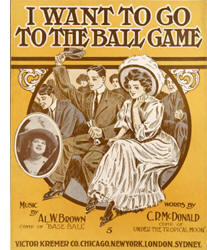
With the great success of Jack
Norworth and Albert Von Tilzer's
1908 song "Take Me Out to the Ball
Game," a number of copycat baseball
songs would soon follow. All having
the theme of taking your girl to
the ball game. Just a year later in
1909, Tin Pan Alley composer Al W.
Brown and C.P. McDonald, took a
swing at producing a similar hit
with "
I Want to Go to the Ball
Game."
It was common for Tin Pan Alley to print various copies of the same sheet
music featuring different photos of
vaudeville singers. This cover of
has a cameo photo of vaudevillian
Lucille Langdon. Other covers
include, Flo Adler, and Lucy Lucier.
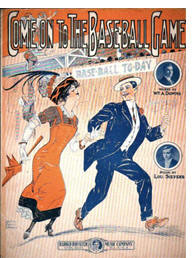
In 1911, William Farmer, and Jos.
McCarthy composed “I’ve Been Making
a Grandstand Play for You.” That
same year "
Come on to the Baseball
Game" was published. The title page
features great cover art by Brotts-
Crews Studios; illustrating Freddie
McCann, the character in the song
taking his girl Molly to the
baseball game. Molly wants to "spoon'neath"
a big shady tree, but Fred said
"All right we'll do that tonight,
But honey please listen to me "Come
on, come on to the baseball game."
The song written by William A.
Downs, and Lou Sievers was
published by Harold Rossiter Music
Company Chicago Illinois. The
company also published the popular
song of the day, "Let Me Call You
Sweetheart" ♪♪I'm in Love with
You♪♪ which is featured on the back
page.
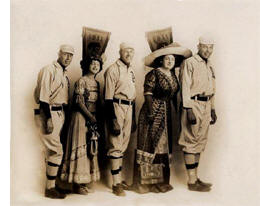
During the early 1900’s most ball
players had regular jobs during the
off-season. Star baseball players
if given the chance would
supplement their winter income by
appearing in vaudeville. Some of
the biggest names in baseball
appeared on the vaudeville stage
including; Babe Ruth, Ty Cobb, Rube
Marquard, Chris Mathewson and
others not as well-known.
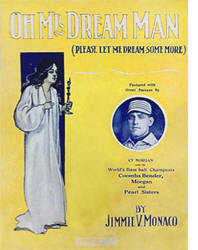
Heading into the off season of
1911, after winning the Word Series
title, Philadelphia Athletic
Champions; Jack Coombs, Chief
Bender and Cy Morgan, known as "The
Minstrel Man of the Diamond,"
headed for the vaudeville stage.
Teaming up with the Pearl Sisters,
the act was called "The Learning
Game," and the players were
advertised to have appeared in the
same uniforms that they wore in the
World Series.
This
sheet music for the song "Oh, Mr.
Dream Man" was part of the skit.
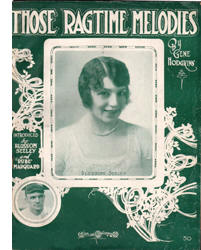
On July 3, 1912, NY Giants Rube
Marquard set a record by winning
his 19th consecutive game. After
the season, the future HOF pitcher
teamed up with vaudeville headliner
Blossom Seeley, to perform a skit
called "Breaking The Record or The
19th Straight."
The act featured a song called "Baseball" Which features a singing solo by
Marguard that ended with a dancing
duet with Seeley. Another
song-and-dance number was performed
alone by Seeley that was called "
Those
Ragtime Melodies."
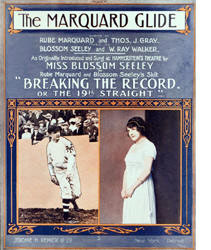
The skit also featured a song that
Marquard and Seeley collaborated on
the music and lyrics called "
The
Marquard Glide" which
celebrates the pitcher's career.
The lyrics were written by Rube
Marquard & Thos. J Gray, music by
Blossom Seeley & W.Ray Walker. The
sheet music published by Jerome H.
Remick & Co. features a
water-colored picture of Rube
Marquard in uniform warming up on
the sidelines, and Blossom Seeley
to the right.
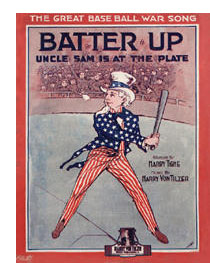
With the "take your girl to the
ball game era" coming to an end,
America and our National pastime
turned it's attention to the war.
During the first World War,
baseball rallied Americans together
to support the war effort.
Military displays became a common
occurrence at ballparks.
Harry Von Tilzer, whose brother
Albert composed the 1908 hit “Take
Me Out to the Ball Game,” created
his
“Batter Up—Uncle Sam is at the
Plate” for these patriotic shows.
Billed as “the great baseball war
song,” it was frequently performed.
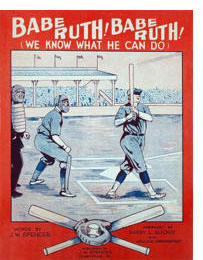
After the war Babe Ruth became the
subject of song and music. One of
the earliest, billed as "the Home
run song hit of the season,"
published in 1919 was "Batterin'
Babe look at him now." Other 'Ruthian
songs' included; "Oh you Babe
Ruth!" published in 1920, "Babe
Ruth" in 1921, another with the
same title in 1922, and "Babe Ruth
Blues" in 1923.
"
Babe Ruth! Babe Ruth! (We Know What He Can Do)” was published in 1928 by
the author, J.W. Spencer, Olneyville, RI. Words by J. W.
Spencer, and arranged by Harry
Alford for the ukulele. The cover
of the sheet music features a
blue-tone illustration of the
Bambino, reminiscent of a picture
taken after Ruth hit his 60th home
run in 1927.
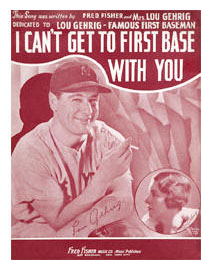
"
I
Can't Get to First Base with You"
by Mrs. Lou Gehrig and Fred Fisher
was published in 1935. The
song was written as part of a
campaign led by Lou Gehrig's wife's
Eleanor of giving the publicly shy
and modest Lou Gehrig, Babe Ruth
type notoriety. To embrace his
celebrity, rather than hide from
it, and encourage Lou to accept the
title of the New York Yankees
Captain.
After Babe Ruth's departure from
the Yankees in 1934, Lou Gehrig was
urged on to take control of the
Yankees leadership in 1935. The
soon to be named Yankees Captain
was encouraged to take on a
different personality. Realizing
that Lou was under pressure to
change, Eleanor wrote a letter to
Lou, telling him to just be
himself, "Just go on to be fine,
true and simple."
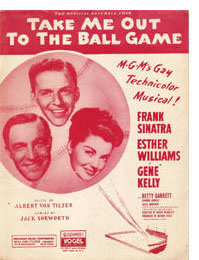
Sheet music from the
1949 MGM
Technicolor musical film, "Take Me
Out to the Ball Game." The movie
stars; Frank Sinatra, Esther
Williams, and Gene Kelly. The title
and nominal theme is taken from
Jack Norworth's 1908 song, "Take Me
Out to the Ball Game." Jack
Norworth later wrote different
verses for the song in 1927, with
"Nelly Kelly" replacing "Katie
Casey."
This was the version used in the 1949 Musical, but shortened. The sheet
music for "Take Me Out to the Ball
Game" was published by the Jerry
Vogel Co. Inc.
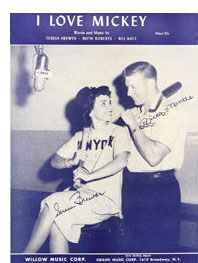
Written By Bill Katz, Ruth Roberts,
and Teresa Brewer,
"I Love Mickey" was recorded on
the Coral record label, by Mickey
Mantle and Teresa Brewer in 1956.
The song features Teresa Brewer
Singing the Lyrics, with Mickey
Mantle Talking Back to her.
The
original sheet music was
copyrighted and published in 1956; by
Willow Music Corp.- Grand music
Corp. "Sole Selling Agent, 1619
Broadway, N.Y." (no zip code) with a
selling price of .50¢. In 1984 the
sheet music was published again by
the Goldenrod Music,. Inc. Port
Chester, N.Y. 10573, and no price.
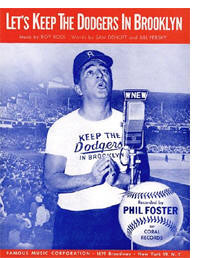
The
sheet music for "Let's Keep the
Dodgers in Brooklyn" was
published by Famous Music
Corporation; music by Roy Ross, words by Sam Denoff and Bill Persk.
Recorded by Phil Foster on Coral
Records, the 1957 song was written
as a futile plea to keep the
Dodgers in Brooklyn. Foster, is best known for
his roll as Frank DeFazio,
Laverne’s pizzeria-owning father,
on the TV hit “Laverne and
Shirley.”
What would Brooklyn be without the
Dodgers? as Sung in Brooklynese
"Like the boids widout a bee widout
Alston and Pewee, And here I am a
poet and I didn’t even know
it...." O’Malley
taink’ the Bums to
California anyway.
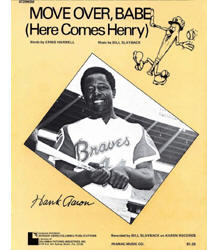 Words written by play-by-play
broadcaster Ernie Harwell, and
music by one time Detroit Tigers
pitcher Bill Slayback; "Move
Over Babe (Here Comes Henry)"
was a song about Hank Aaron's
journey in overtaking Babe Ruth for
the all-time home run record.
Words written by play-by-play
broadcaster Ernie Harwell, and
music by one time Detroit Tigers
pitcher Bill Slayback; "Move
Over Babe (Here Comes Henry)"
was a song about Hank Aaron's
journey in overtaking Babe Ruth for
the all-time home run record.
In 1973, Slayback recorded the song
on the Karen records label. The
sheet music published by Iramac
Music Co., features 'Hamerin Hank"
on the cover title page, and also
pictures Harwell, and Slayback on
the back. "...Move over Babe,
Hank’s hit another"

